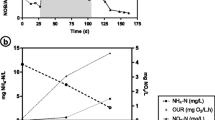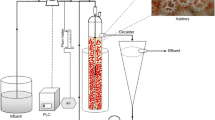Abstract
The process of nitrification–denitrification via nitrite for nitrogen removal under real-time control mode was tested in two laboratory-scale sequencing batch reactors (SBRs) with flocculent activated sludge (R1) and aerobic granular sludge (R2) to compare operational performance and real-time control strategies. The results showed that the average ammonia nitrogen, total inorganic nitrogen (TIN), and chemical oxygen demand (COD) removal during aeration phase were 97.6%, 57.0%, and 90.1% in R2 compared with 98.6%, 48.7%, and 88.1% in R1. The TIN removed in both SBRs was partially due to the presence of simultaneous nitrification–denitrification via nitrite, especially in R2. The specific nitrification and denitrification rates in R2 were 0.0416 mgNH +4 –N/gSS-min and 0.1889 mgNO −X –N/gSS-min, which were 1.48 times and 1.35 times that of R1. The higher rates for COD removal, nitrification, and denitrification were achieved in R2 than R1 with similar influent quality. Dissolved oxygen (DO), pH, and oxidization reduction potential, corresponding to nutrient variations, were used as diagnostic parameters to control the organic carbon degradation and nitrification–denitrification via nitrite processes in both SBRs. The online control strategy of granular SBR was similar to that of the SBR with flocculent activated sludge. However, a unique U-type pattern on the DO curve in granular SBR was different from SBR with flocculent activated sludge in aerobic phase.






Similar content being viewed by others
References
Adav SS, Lee DJ, Show KY, Tay JH (2008) Aerobic granular sludge: recent advances. Biotechnol Adv 26:411–423
APHA-AWWA-WEF (2005) Standard methods for the examination of water and wastewater, 21st edn. American Public Health Association/American Water Works Association/Water Environment Federation, Washington
Casellas M, Dagot C, Baudu M (2006) Set up and assessment of a control strategy in a SBR in order to enhance nitrogen and phosphorus removal. Process Biochem 41:1994–2001
Cassidy DP, Belia E (2005) Nitrogen and phosphorus removal from an abattoir wastewater in a SBR with aerobic granular sludge. Water Res 39:4817–4823
Chung J, Bae W, Lee YW, Rittmann BE (2007) Shortcut biological nitrogen removal in hybrid biofilm/suspended growth reactors. Process Biochem 42:320–328
de Kreuk MK, Heijnen JJ, van Loosdrecht MCM (2005) Simutaneous COD, nitrogen and phosphate removal by aerobic granular sludge. Biotechnol Bioeng 90:761–769
de Kreuk MK, Kishida N, van Loosdrecht MCM (2007) Aerobic granular sludge—state of the art. Water Sci Technol 155:79–81
Eum Y, Choi E (2002) Optimization of nitrogen removal from piggery waste by nitrite nitrification. Water Sci Technol 45:89–96
Gao DW, Peng YZ, Liang H, Wang P (2003) Using oxidation–reduction potential (ORP) and pH value for process control of shortcut nitrification–denitrification. J Environ Sci Health 38:2933–2942
Gao DW, Peng YZ, Li BK, Liang H (2009) Shortcut nitrification–denitrification by real-time control strategies. Bioresour Technol 100:2298–2300
Guo JH, Yang Q, Peng YZ, Yang AM, Wang SY (2007) Biological nitrogen removal with real-time control using step-feed SBR technology. Enzyme Microb Technol 40:1564–1569
Han DW, Chang JS, Kim DJ (2003) Nitrifying microbial community analysis of nitrite accumulating biofilm reactor by fluorescence in situ hybridization. Water Sci Technol 47:97–104
Hellinga C, Schellen AAJC, Mulder JW, van Loosdrecht MCM, Heijnen JJ (1998) The SHARON process: an innovative method for nitrogen removal from ammonium-rich wastewater. Water Sci Technol 37:135–142
Holman JB, Wareham DG (2005) COD, ammonia and dissolved oxygen time profile in the simultaneous nitrification/denitrification process. Biochem Eng J 22:125–133
Kim DJ, Chang JS, Lee DI, Han DW, Yoo IK, Cha GC (2003) Nitrification of high strength ammonia wastewater and nitrite accumulation characteristics. Water Sci Technol 47:45–51
Kim J, Chen M, Kishida N, Sudo R (2004) Integrated real-time control strategy for nitrogen removal in swine wastewater using sequencing batch reactors. Water Res 38:3340–3348
Kishida N, Kim JH, Chen M, Sasaki H, Sudo R (2003) Effectiveness of oxidation-reduction potential and pH as monitoring and control parameters for nitrogen removal in swine wastewater treatment by sequencing batch reactors. J Biosci Bioeng 96:285–290
Kishida N, Kim JH, Tsuneda S, Sudo R (2006) Anaerobic/oxic/anoxic granular sludge process as an effective nutrient removal process utilizing denitrifying polyphasphate-accumulating organisms. Water Res 40:2303–2310
Lemaire R, Meyer R, Taske A, Crocetti GR, Keller J, Yuan ZG (2006) Identifying causes for N2O accumulation in a lab-scale sequencing batch reactor performing simultaneous nitrification, denitrification and phosphorus removal. J Biotech 122:62–72
Li Y, Liu Y (2005) Diffusion of substrate and oxygen in aerobic granule. Biochem Eng J 27:45–52
Liu Y, Tay JH (2004) State of the art of biogranulation technology for wastewater treatment. Biotechnol Adv 22:533–563
Marsili-Libelli S (2006) Control of SBR switching by fuzzy pattern recognition. Water Res 40:1095–1107
Morgenroth E, Sherden T, Van Loosdrecht MCM, Heijnen JJ, Wilderer PA (1997) Aerobic granular sludge in a sequencing batch reactor. Water Res 31:3191–3194
Mosquera-Corral A, de Kreuk MK, Heijnen JJ, van Loosdrecht MCM (2005) Effects of oxygen concentration on N-removal in an aerobic granular sludge reactor. Water Res 39:2676–2686
Mulder JW, van Loosdrecht MCM, Hellinga C, van Kempen R (2001) Full-scale application of the SHARON process for the treatment of rejection water of digested sludge dewatering. Water Sci Technol 43:127–134
Ni BJ, Yu HQ, Sun YJ (2008) Modeling simultaneous autotrophic and heterotrophic growth in aerobic granules. Water Res 42:1583–1594
Ni BJ, Xie WM, Liu SG, Yu HQ, Wang YZ, Wang G, Dai XL (2009) Granulation of activated sludge in a pilot-scale sequencing batch reactor for the treatment of low-strength municipal wastewater. Water Res 43:751–761
Peng YZ, Chen Y, Peng CY, Liu M, Wang SY, Song XQ, Cui YW (2004) Nitrite accumulation by aeration controlled in sequencing batch reactors treating domestic wastewater. Water Sci Technol 50:35–43
Rittmann BE, McCarty PL (2001) Environmental biotechnology: principles and applications. McGraw-Hill, New York
Ruiz G, Jeison D, Chamy R (2003) Nitrification with high nitrite accumulation for the treatment of wastewater with high ammonia concentration. Water Res 37:1371–1377
Tanwar P, Nandy T, Ukey P, Manekar P (2008) Correlating on-line monitoring parameters, pH, DO and ORP with nutrient removal in an intermittent cyclic process bioreactor system. Bioresour Technol 99:7630–7635
Tay JH, Ivanov V, Pan S, Tay STL (2002) Specific layers in aerobically grown microbial granules. Lett Appl Microbiol 34:254–257
Traoré A, Grieu S, Puig S, Corominas L, Thiery F, Polit M, Colprim J (2005) Fuzzy control of dissolved oxygen in a sequencing batch reactor pilot plant. Chem Eng J 111:13–19
Van Dongen U, Jetten MSM, Van Loosdrecht MCM (2001) The SHARON-ANAMMOX process for treatment of ammonium rich wastewater. Water Sci Technol 44:53–60
Wang F, Xia SQ, Liu Y, Chen XS, Zhang J (2007) Community analysis of ammonia and nitrite oxidizers in start-up of aerobic granular sludge reactor. J Environ Sci 19:996–1002
Wang JL, Peng YZ, Wang SY, Gao YQ (2008) Nitrogen removal by simultaneous nitrification and denitrification via nitrite in a sequence hybrid biological reactor. Chin J Chem Eng 16:778–784
Yang XN, He JG, Jiang T (2008) Effects of aeration volume and alkalinity on simultaneous nitrification and denitrification (SND) of aerobic granular sludge sequencing batch reactor. Abstr J Biotechnol 136S:S647–S677
Yuan XJ, Gao DW (2010) Effect of dissolved oxygen on nitrogen removal and process control in aerobic granular sludge reactor. J Hazard Mater 178:1041–1045
Acknowledgments
This research was supported by the Foundation for Author of National Excellent Doctoral Dissertation of the P.R. China (FANEDD, no. 200544), and the Research Fund for the Doctoral Program of Higher Education, Ministry of Education of the P. R. China (20092302110059), Heilongjiang Natural Science Fund for Distinguished Young Scientists (JC200909), and the Scientific Research Foundation for the Innovative Talents, Harbin City Government (2007RFLXS002).
Author information
Authors and Affiliations
Corresponding author
Rights and permissions
About this article
Cite this article
Gao, D., Yuan, X., Liang, H. et al. Comparison of biological removal via nitrite with real-time control using aerobic granular sludge and flocculent activated sludge. Appl Microbiol Biotechnol 89, 1645–1652 (2011). https://doi.org/10.1007/s00253-010-2950-3
Received:
Revised:
Accepted:
Published:
Issue Date:
DOI: https://doi.org/10.1007/s00253-010-2950-3




